Validation and Verification of containmentFOAM CFD Simulations in Hydrogen Safety
Abstract
:1. Introduction
2. CFD Simulation Solver
2.1. The containmentFOAM Package
2.2. Solution for Unsteady Multi-Species Gas Mixture
2.3. k- SST Turbulence Model and Its Modification for Buoyancy
3. The Validation Cases
3.1. The Validation Strategy and Matrix
3.2. Hallway Leakage Experiment
3.2.1. Experimental Setup
3.2.2. Numerical Setup
3.2.3. Grid Independence Study
3.2.4. Simulations Results and Discussion
3.3. The FLAME Experiments
3.3.1. Experimental Setup
3.3.2. Numerical Setup
3.3.3. Grid Independence Study
3.3.4. Simulations Results and Discussion
3.4. The GAMELAN Experiments
3.4.1. Experimental Setup
3.4.2. Numerical Setup
3.4.3. Grid Independence Study
3.4.4. Simulation Results and Discussion
4. General Discussion
5. Conclusions and Future Directions
Author Contributions
Funding
Acknowledgments
Conflicts of Interest
Abbreviations
| CEA | French Alternative Energies and Atomic Energy Commission |
| FLAME | Fire Laboratory for Accreditation of Models by Experiments |
| LFL | Lower flammability limit |
| PDEs | Partial differential equations |
| PIV | Particle image velocimetry |
| PLIF | Planar laser-induced fluorescence |
| SGDH | Simple gradient diffusion hypothesis |
| SST | Shear stress tensor |
| Subscripts and superscripts | |
| i | species index |
| k | related to the turbulence kinetic energy |
| t | turbulence value |
| related to the specific rate of turbulence dissipation | |
References
- Kotchourko, A.; Jordan, T. Hydrogen Safety for Energy Applications: Engineering Design, Risk Assessment, and Codes and Standards; Butterworth-Heinemann: Oxford, UK, 2022. [Google Scholar]
- Dunn, S. Hydrogen futures: Toward a sustainable energy system. Int. J. Hydrogen Energy 2002, 27, 235–264. [Google Scholar] [CrossRef]
- Ehret, O.; Bonhoff, K. Hydrogen as a fuel and energy storage: Success factors for the German Energiewende. Int. J. Hydrogen Energy 2015, 40, 5526–5533. [Google Scholar] [CrossRef]
- Swain, M.R.; Grilliot, E.S.; Swain, M.N. Risks Incurred by Hydrogen Escaping from Containers and Conduits; Technical Report; National Renewable Energy Lab. (NREL): Golden, CO, USA, 1998. [Google Scholar]
- Matsuura, K.; Kanayama, H.; Tsukikawa, H.; Inoue, M. Numerical simulation of leaking hydrogen dispersion behavior in a partially open space. Int. J. Hydrogen Energy 2008, 33, 240–247, IWHE 2006. [Google Scholar] [CrossRef]
- Matsuura, K. Effects of the geometrical configuration of a ventilation system on leaking hydrogen dispersion and accumulation. Int. J. Hydrogen Energy 2009, 34, 9869–9878. [Google Scholar] [CrossRef]
- Matsuura, K.; Nakano, M.; Ishimoto, J. Forced ventilation for sensing-based risk mitigation of leaking hydrogen in a partially open space. Int. J. Hydrogen Energy 2010, 35, 4776–4786. [Google Scholar] [CrossRef]
- Matsuura, K.; Nakano, M.; Ishimoto, J. Sensing-based risk mitigation control of hydrogen dispersion and accumulation in a partially open space with low-height openings by forced ventilation. Int. J. Hydrogen Energy 2012, 37, 1972–1984. [Google Scholar] [CrossRef]
- Hajji, Y.; Bouteraa, M.; Cafsi, A.E.; Belghith, A.; Bournot, P.; Kallel, F. Dispersion and behavior of hydrogen during a leak in a prismatic cavity. Int. J. Hydrogen Energy 2014, 39, 6111–6119. [Google Scholar] [CrossRef]
- Hajji, Y.; Jouini, B.; Bouteraa, M.; Elcafsi, A.; Belghith, A.; Bournot, P. Numerical study of hydrogen release accidents in a residential garage. Int. J. Hydrogen Energy 2015, 40, 9747–9759. [Google Scholar] [CrossRef]
- Cariteau, B.; Tkatschenko, I. Experimental study of the effects of vent geometry on the dispersion of a buoyant gas in a small enclosure. Int. J. Hydrogen Energy 2013, 38, 8030–8038. [Google Scholar] [CrossRef]
- Cariteau, B.; Brinster, J.; Tkatschenko, I. Experiments on the distribution of concentration due to buoyant gas low flow rate release in an enclosure. Int. J. Hydrogen Energy 2011, 36, 2505–2512. [Google Scholar] [CrossRef]
- Giannissi, S.; Shentsov, V.; Melideo, D.; Cariteau, B.; Baraldi, D.; Venetsanos, A.; Molkov, V. CFD benchmark on hydrogen release and dispersion in confined, naturally ventilated space with one vent. Int. J. Hydrogen Energy 2015, 40, 2415–2429. [Google Scholar] [CrossRef]
- Giannissi, S.; Hoyes, J.; Chernyavskiy, B.; Hooker, P.; Hall, J.; Venetsanos, A.; Molkov, V. CFD benchmark on hydrogen release and dispersion in a ventilated enclosure: Passive ventilation and the role of an external wind. Int. J. Hydrogen Energy 2015, 40, 6465–6477. [Google Scholar] [CrossRef]
- Hussein, H.; Brennan, S.; Molkov, V. Dispersion of hydrogen release in a naturally ventilated covered car park. Int. J. Hydrogen Energy 2020, 45, 23882–23897. [Google Scholar] [CrossRef]
- Cariteau, B.; Brinster, J.; Studer, E.; Tkatschenko, I.; Joncquet, G. Experimental results on the dispersion of buoyant gas in a full scale garage from a complex source. Int. J. Hydrogen Energy 2011, 36, 2489–2496. [Google Scholar] [CrossRef]
- Gupta, S.; Brinster, J.; Studer, E.; Tkatschenko, I. Hydrogen related risks within a private garage: Concentration measurements in a realistic full scale experimental facility. Int. J. Hydrogen Energy 2009, 34, 5902–5911. [Google Scholar] [CrossRef]
- Papanikolaou, E.; Venetsanos, A.; Heitsch, M.; Baraldi, D.; Huser, A.; Pujol, J.; Garcia, J.; Markatos, N. HySafe SBEP-V20: Numerical studies of release experiments inside a naturally ventilated residential garage. Int. J. Hydrogen Energy 2010, 35, 4747–4757. [Google Scholar] [CrossRef] [Green Version]
- Swain, M.; Grilliot, E.; MN, S. Phase 2: Risks in indoor vehicle storage. Add. Hydrog. Veh. Saf. Rep. 1998, 35–37. [Google Scholar]
- Hooker, P.; Hoyes, J.; Hall, J. Accumulation of Hydrogen Released into an Enclosure Fitted with Passive Vents–Experimental Results and Simple Models; Hazards XXIV: Edinburgh, UK, 2014; pp. 7–9. [Google Scholar]
- Liang, Z.; McKenna, A.; Clouthier, T.; David, R. Experimental study on accumulation of helium released into a semi-confined enclosure with distributed leaks. Int. J. Hydrogen Energy 2021, 46, 12522–12532. [Google Scholar] [CrossRef]
- Venetsanos, A.G.; Papanikolaou, E.; Delichatsios, M.; Garcia, J.; Hansen, O.; Heitsch, M.; Huser, A.; Jahn, W.; Jordan, T.; Lacome, J.M.; et al. An inter-comparison exercise on the capabilities of CFD models to predict the short and long term distribution and mixing of hydrogen in a garage. Int. J. Hydrogen Energy 2009, 34, 5912–5923. [Google Scholar] [CrossRef]
- Giannissi, S.G.; Tolias, I.C.; Melideo, D.; Baraldi, D.; Shentsov, V.; Makarov, D.; Molkov, V.; Venetsanos, A.G. On the CFD modelling of hydrogen dispersion at low-Reynolds number release in closed facility. Int. J. Hydrogen Energy 2021, 46, 29745–29761. [Google Scholar] [CrossRef]
- Kelm, S.; Kampili, M.; Liu, X.; George, A.; Schumacher, D.; Druska, C.; Struth, S.; Kuhr, A.; Ramacher, L.; Allelein, H.J.; et al. The Tailored CFD Package ‘containmentFOAM’ for Analysis of Containment Atmosphere Mixing, H2/CO Mitigation and Aerosol Transport. Fluids 2021, 6, 100. [Google Scholar] [CrossRef]
- Abe, S.; Ishigaki, M.; Sibamoto, Y.; Yonomoto, T. RANS analyses on erosion behavior of density stratification consisted of helium–air mixture gas by a low momentum vertical buoyant jet in the PANDA test facility, the third international benchmark exercise (IBE-3). Nucl. Eng. Des. 2015, 289, 231–239. [Google Scholar] [CrossRef]
- Kampili, M.; Kumar, G.V.; Kelm, S.; Prakash, K.A.; Allelein, H.J. Validation of Multicomponent Species Transport Solver-Impact of Buoyancy Turbulence in Erosion of a Stratified Light Gas Layer. 2019. Available online: https://juser.fz-juelich.de/record/865676 (accessed on 10 June 2023).
- Menter, F.; Esch, T. Elements of industrial heat transfer predictions. In Proceedings of the 16th Brazilian Congress of Mechanical Engineering (COBEM), Minas Gerais, Brazil, 26–30 November 2001; Volume 109, p. 650. [Google Scholar]
- Versteeg, H.K.; Malalasekera, W. An Introduction to Computational Fluid Dynamics: The Finite Volume Method; Pearson Education: London, UK, 2007. [Google Scholar]
- O’hern, T.; Weckman, E.; Gerhart, A.; Tieszen, S.; Schefer, R. Experimental study of a turbulent buoyant helium plume. J. Fluid Mech. 2005, 544, 143–171. [Google Scholar] [CrossRef]
- Qian, J.Y.; Li, X.J.; Gao, Z.X.; Jin, Z.J. A numerical study of hydrogen leakage and diffusion in a hydrogen refueling station. Int. J. Hydrogen Energy 2020, 45, 14428–14439. [Google Scholar] [CrossRef]
- Des Jardin, P.E.; O’Hern, T.J.; Tieszen, S.R. Large eddy simulation and experimental measurements of the near-field of a large turbulent helium plume. Phys. Fluids 2004, 16, 1866–1883. [Google Scholar] [CrossRef]
- Maragkos, G.; Rauwoens, P.; Wang, Y.; Merci, B. Large eddy simulations of the flow in the near-field region of a turbulent buoyant helium plume. Flow Turbul. Combust. 2013, 90, 511–543. [Google Scholar] [CrossRef]
- Maragkos, G.; Funk, E.; Merci, B. Analysis of adaptive mesh refinement in a turbulent buoyant helium plume. Int. J. Numer. Methods Fluids 2022, 94, 1398–1415. [Google Scholar] [CrossRef]
- Chung, W.; Devaud, C. Buoyancy-corrected k–ε models and large eddy simulation applied to a large axisymmetric helium plume. Int. J. Numer. Methods Fluids 2008, 58, 57–89. [Google Scholar] [CrossRef]
- Chung, W. A CFD Investigation of Turbulent Buoyant Helium Plumes. Master’s Thesis, University of Waterloo, Waterloo, ON, Canada, 2007. [Google Scholar]
- Juretić, F. cfMesh User Guide (v1.1); Creative Fields, Ltd.: Zagreb, Croatia, 2015. [Google Scholar]
- Giannissi, S.; Venetsanos, A.G. HyFOAM Tutorial, Hydrogen/Helium Dispersion in Vented Enclosures. e-Laboratory.
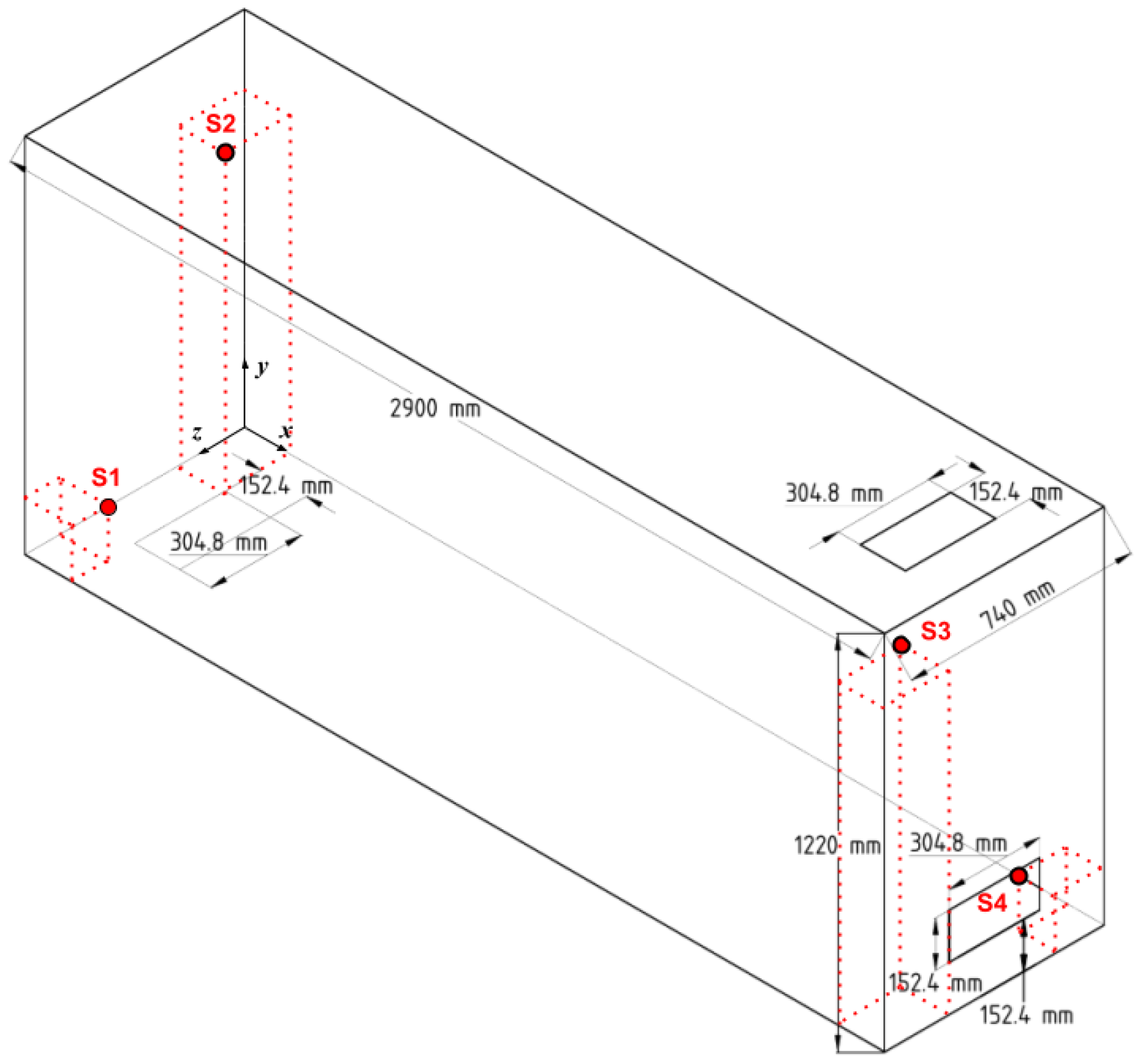
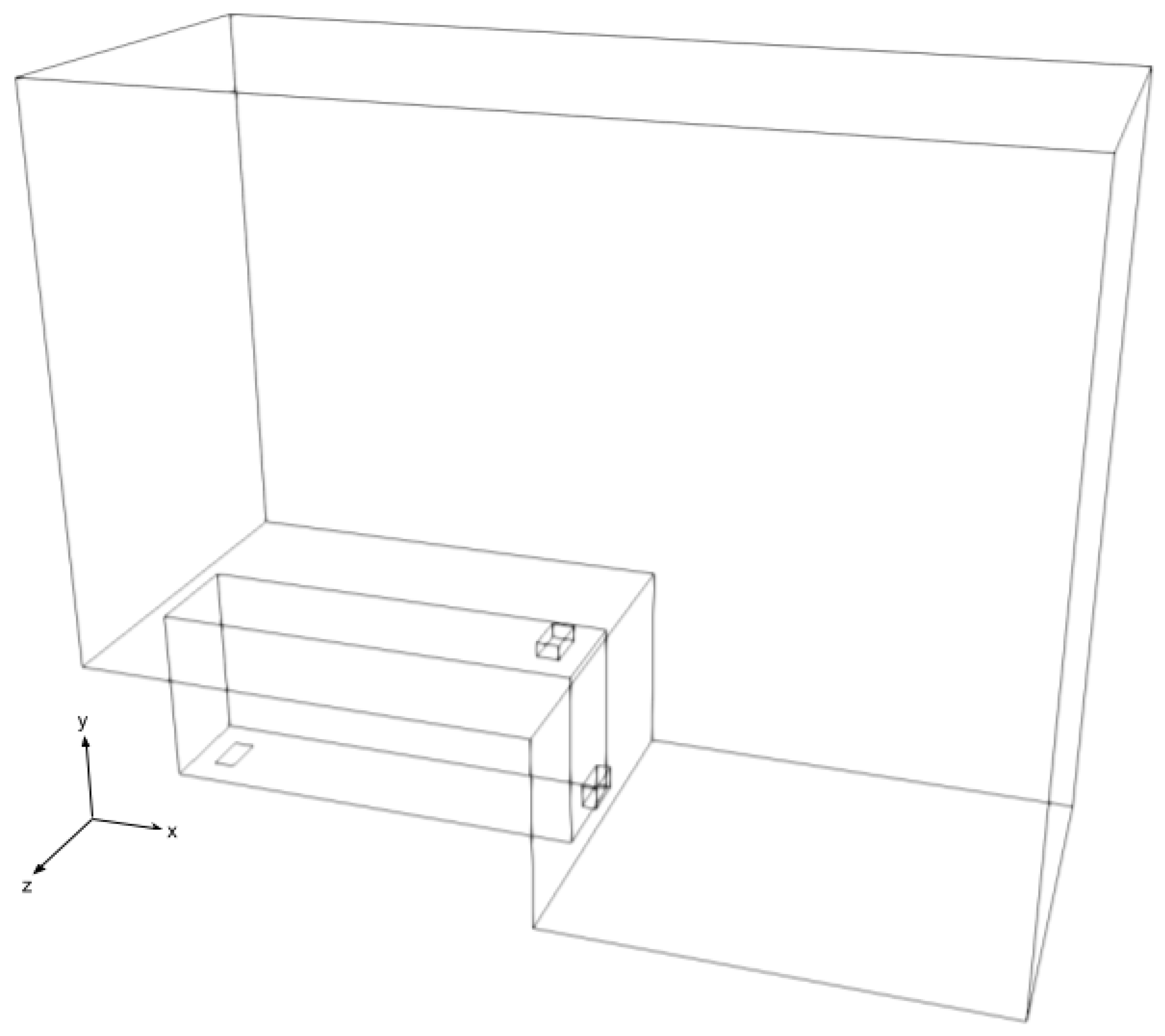

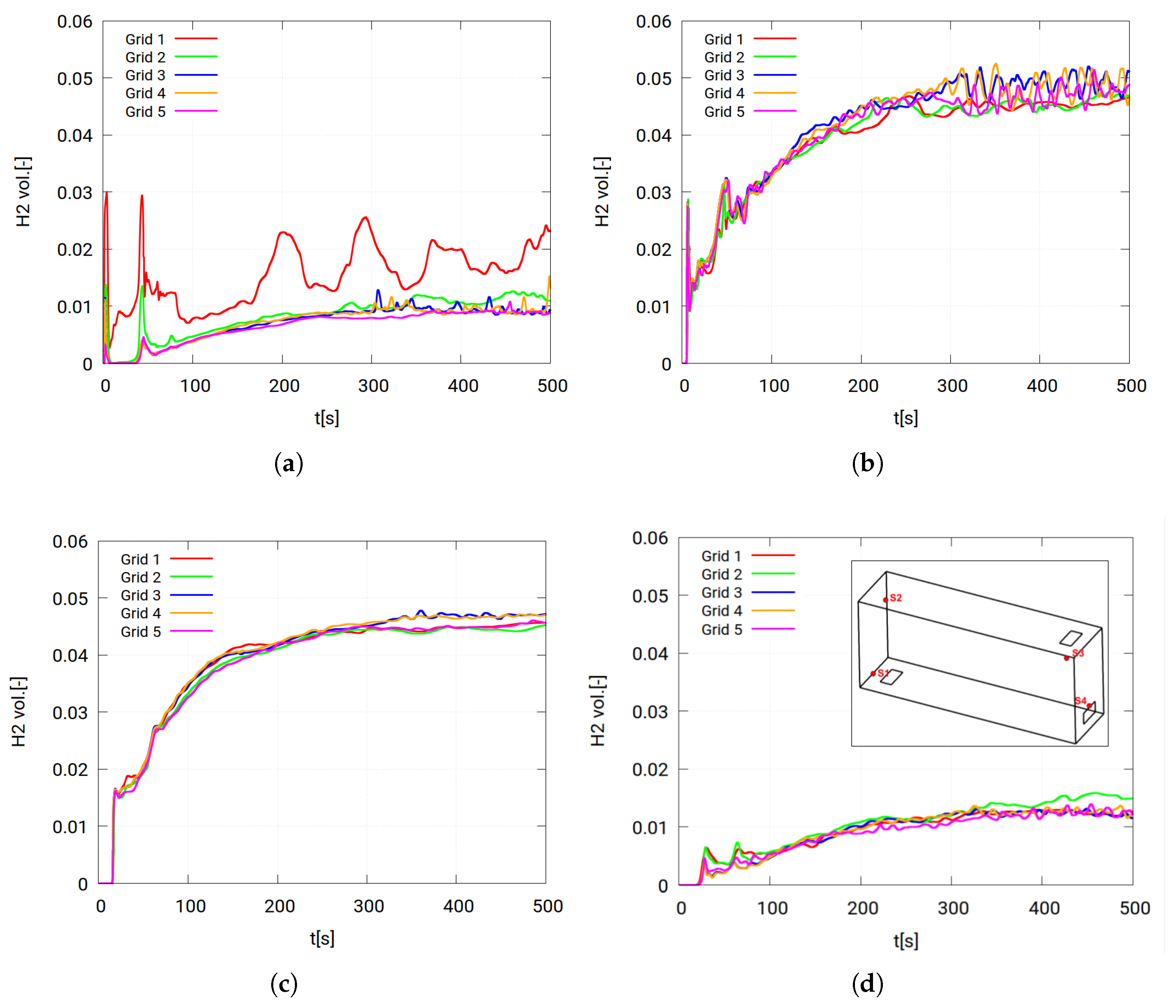

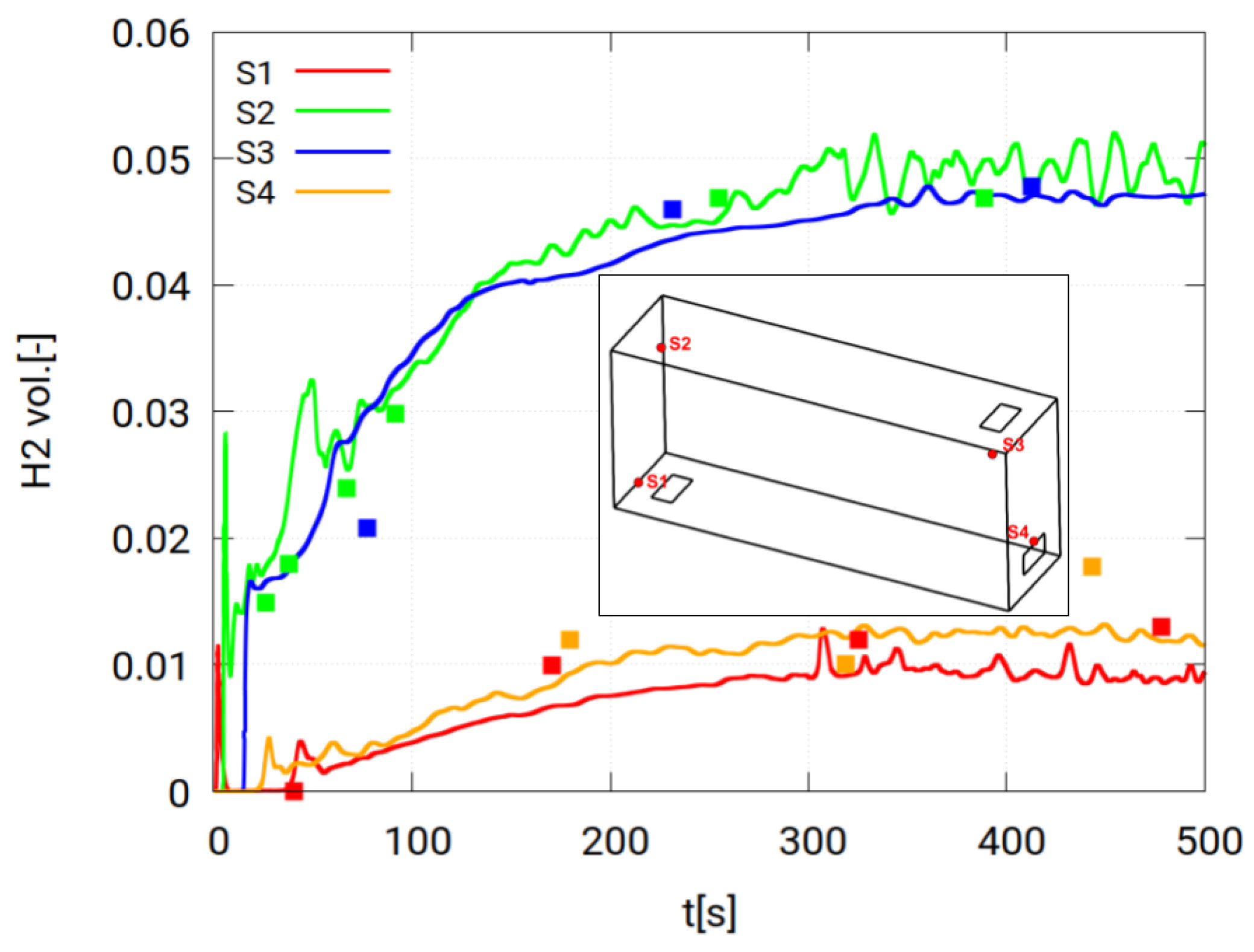
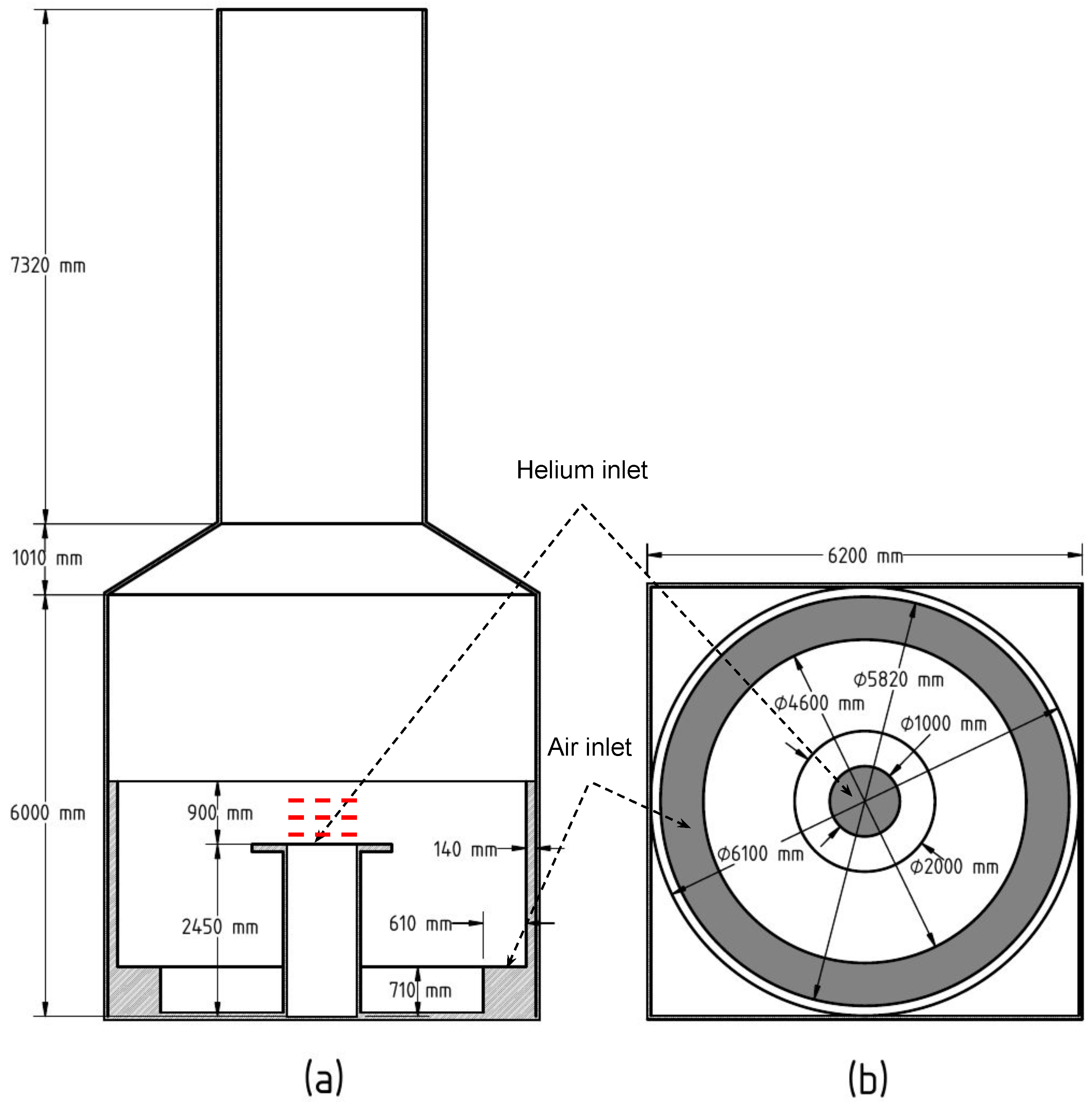
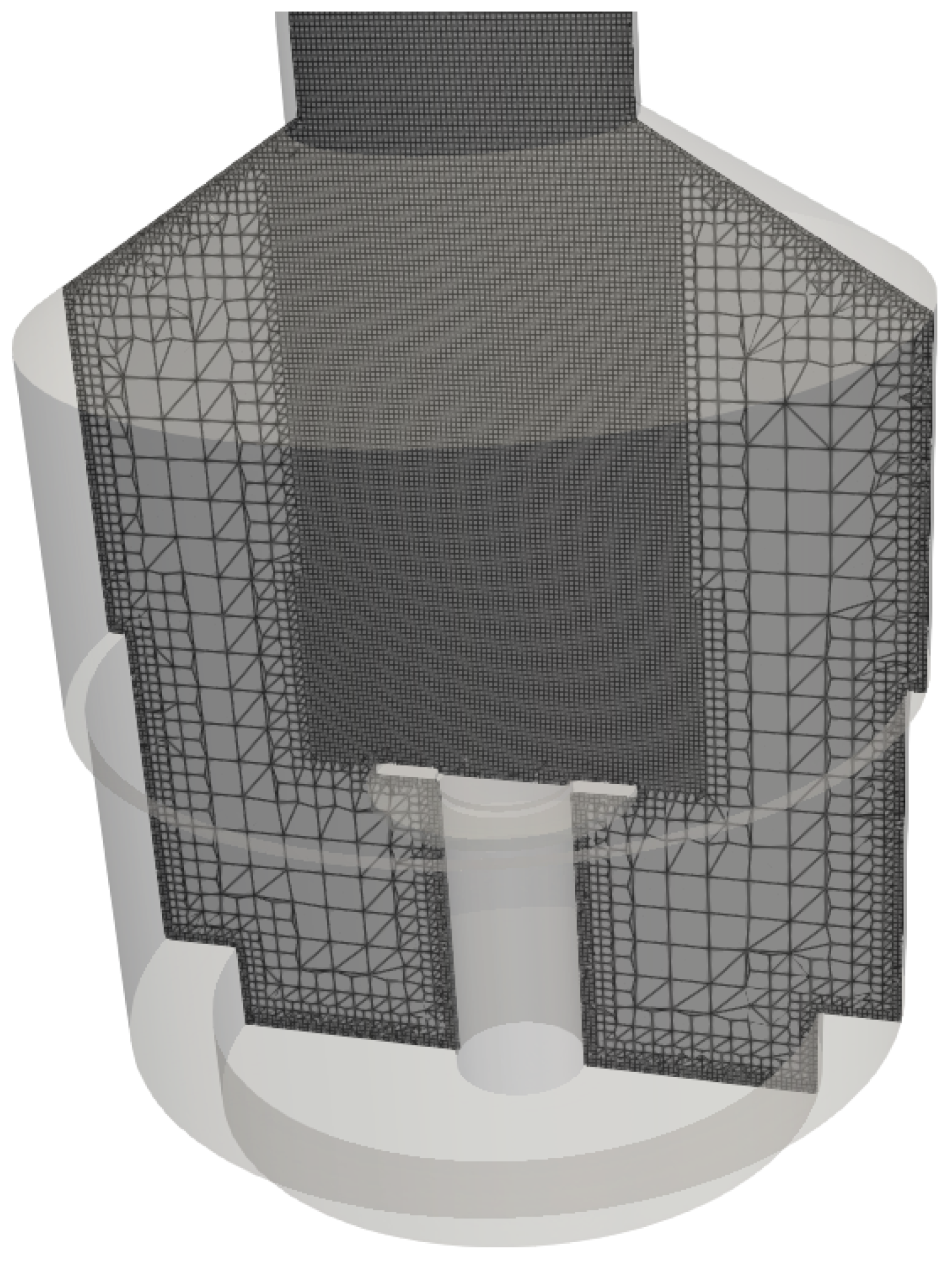
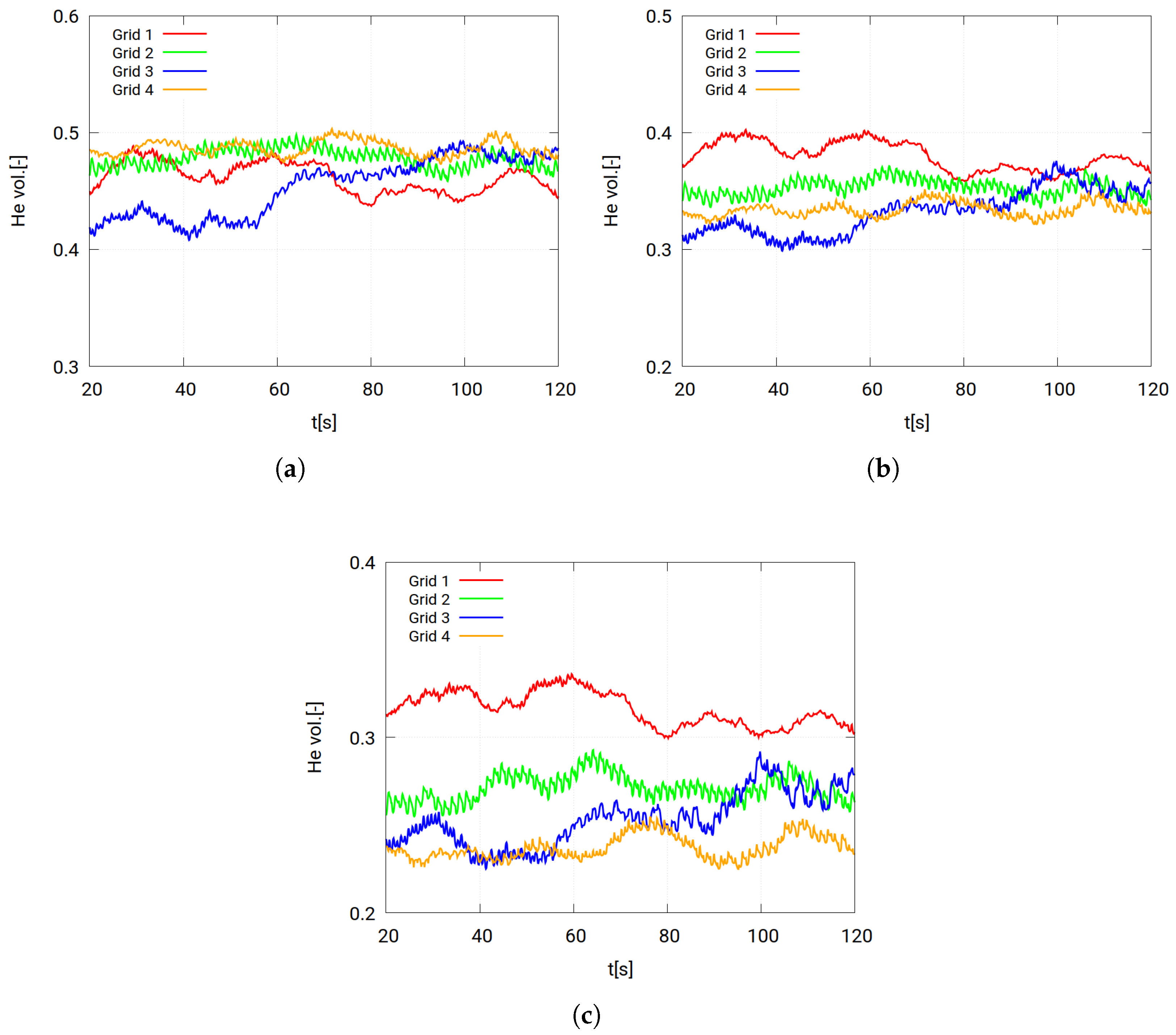

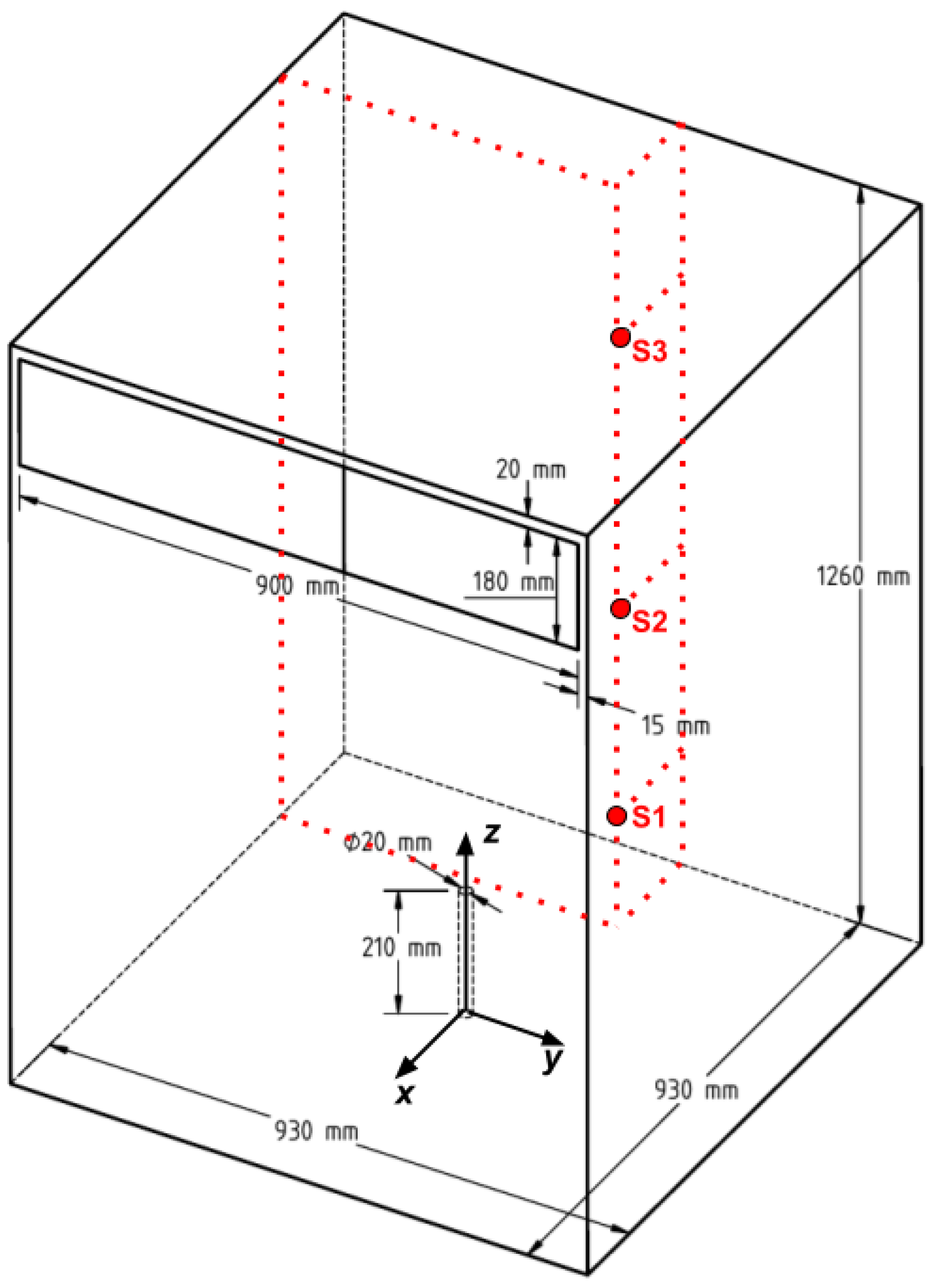

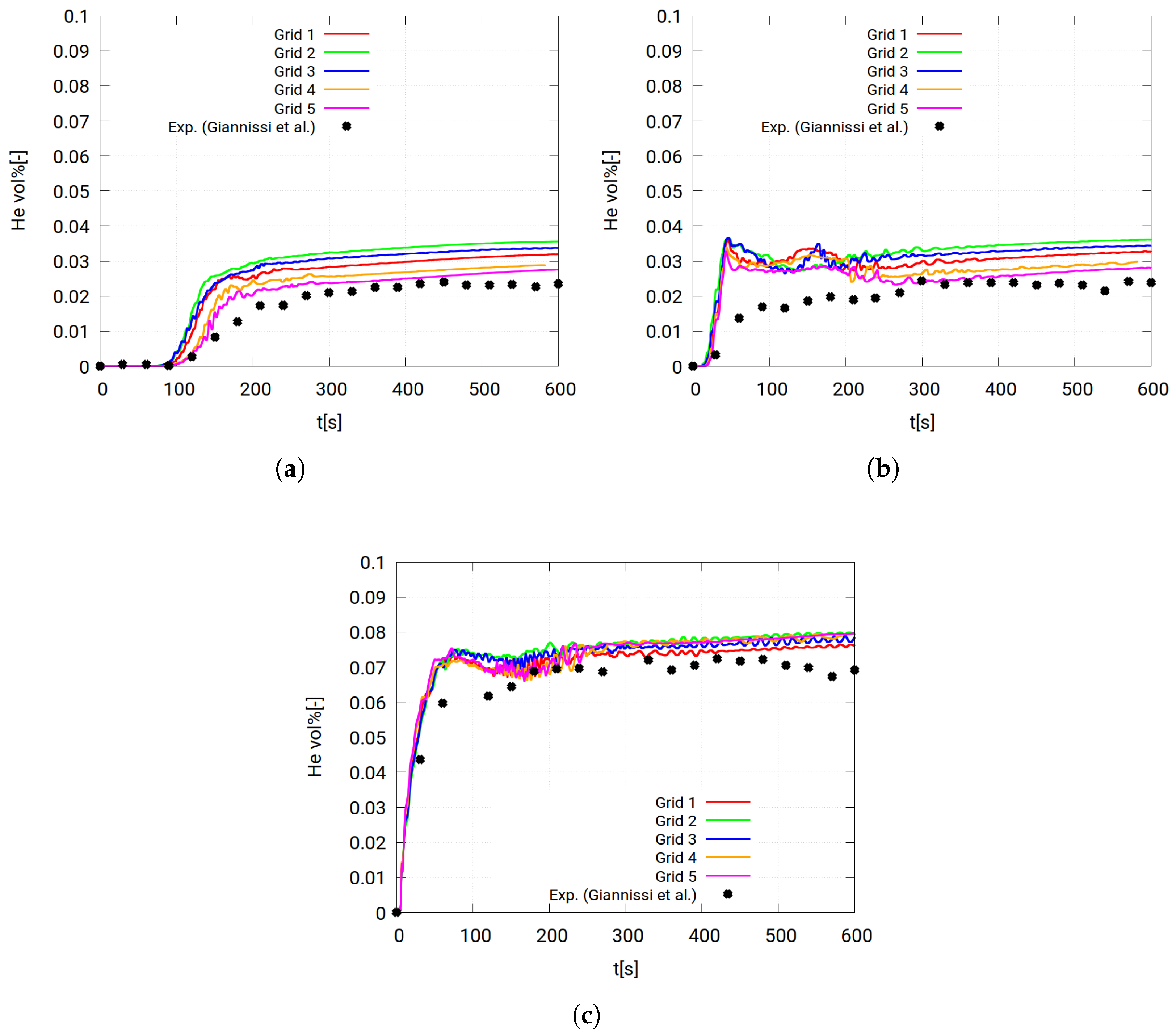
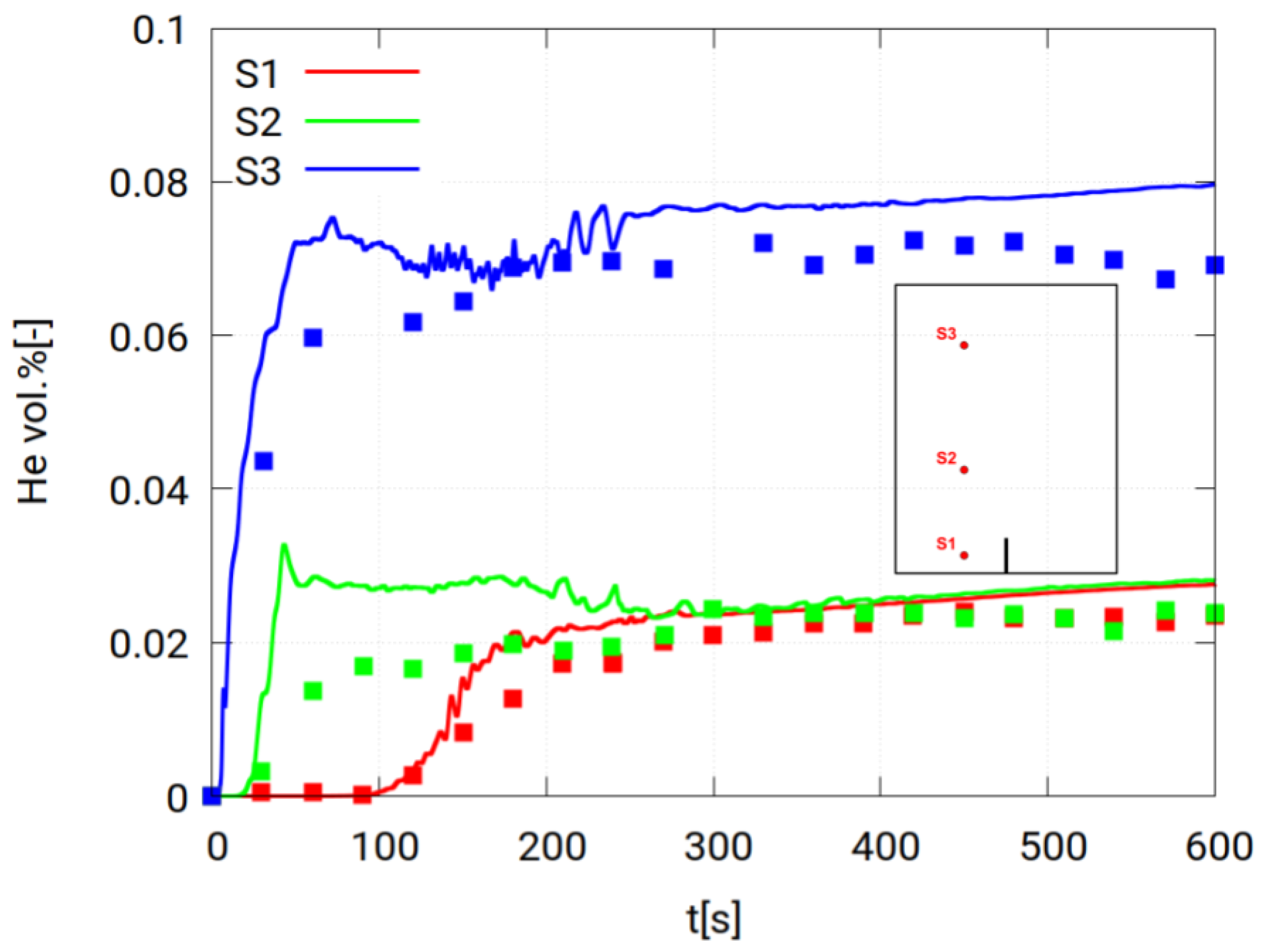

| Phenomenon | Hallway Leakage | FLAME | GAMELAN |
|---|---|---|---|
| Buoyancy | √ | √ | √ |
| Stratification | √ | √ | |
| Buoyancy-driven | √ | √ | √ |
| Momentum-driven | √ | ||
| Jet-to-plume trans. | √ | ||
| Data | |||
| Concentrations | point | profile | point |
| Flow | point | point | point |
| Sensor | x [m] | y [m] | z [m] |
|---|---|---|---|
| S1 | 0.152 | 0.152 | 0.596 |
| S2 | 0.152 | 1.009 | 0.219 |
| S3 | 2.676 | 1.009 | 0.596 |
| S4 | 2.676 | 0.152 | 0.219 |
| Grid No. | No. of Cells in the Hallway | Total No. of Cells | Inlet Patch Cells | ||
|---|---|---|---|---|---|
| x | y | z | |||
| 1 | 94 | 22 | 24 | 130,532 | 80 |
| 2 | 125 | 28 | 32 | 345,560 | 120 |
| 3 | 185 | 36 | 45 | 473,340 | 180 |
| 4 | 185 | 36 | 45 | 790,100 | 288 |
| 5 | 215 | 60 | 45 | 1,134,500 | 540 |
| Grid No. | Number of Cells | Inlet Patch Cells |
|---|---|---|
| 1 | 709,316 | 292 |
| 2 | 973,212 | 344 |
| 3 | 1,623,918 | 608 |
| 4 | 2,080,594 | 756 |
| Grid No. | No. of Cells in the Chamber | Total Cells in Domain | Inlet Patch Cells | |||
|---|---|---|---|---|---|---|
| x | y | z | Total | |||
| 1 | 57 | 24 | 62 | 116,726 | 324,034 | 20 |
| 2 | 80 | 35 | 74 | 193,116 | 439,900 | 32 |
| 3 | 101 | 47 | 91 | 401,139 | 703,241 | 66 |
| 4 | 128 | 59 | 110 | 773,280 | 1,132,044 | 112 |
| 5 | 152 | 71 | 126 | 1,264,160 | 1,692,660 | 170 |
Disclaimer/Publisher’s Note: The statements, opinions and data contained in all publications are solely those of the individual author(s) and contributor(s) and not of MDPI and/or the editor(s). MDPI and/or the editor(s) disclaim responsibility for any injury to people or property resulting from any ideas, methods, instructions or products referred to in the content. |
© 2023 by the authors. Licensee MDPI, Basel, Switzerland. This article is an open access article distributed under the terms and conditions of the Creative Commons Attribution (CC BY) license (https://creativecommons.org/licenses/by/4.0/).
Share and Cite
Yassin, K.; Kelm, S.; Kampili, M.; Reinecke, E.-A. Validation and Verification of containmentFOAM CFD Simulations in Hydrogen Safety. Energies 2023, 16, 5993. https://doi.org/10.3390/en16165993
Yassin K, Kelm S, Kampili M, Reinecke E-A. Validation and Verification of containmentFOAM CFD Simulations in Hydrogen Safety. Energies. 2023; 16(16):5993. https://doi.org/10.3390/en16165993
Chicago/Turabian StyleYassin, Khaled, Stephan Kelm, Manohar Kampili, and Ernst-Arndt Reinecke. 2023. "Validation and Verification of containmentFOAM CFD Simulations in Hydrogen Safety" Energies 16, no. 16: 5993. https://doi.org/10.3390/en16165993
APA StyleYassin, K., Kelm, S., Kampili, M., & Reinecke, E.-A. (2023). Validation and Verification of containmentFOAM CFD Simulations in Hydrogen Safety. Energies, 16(16), 5993. https://doi.org/10.3390/en16165993






